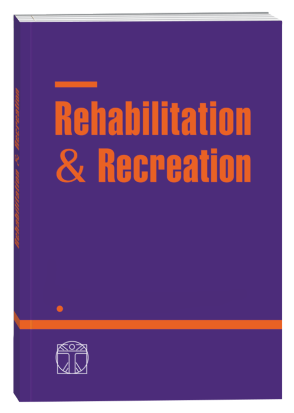ANALYSIS OF THE FORMATION OF STUDENTS’ HEALTH-SAVING COMPETENCE ACCORDING TO THE RESULTS OF INTRODUCTION INTO THE EDUCATIONAL PROCESS OF GUIDED INDEPENDENT WORK
DOI:
https://doi.org/10.32782/2522-1795.2021.9.8Keywords:
technology, health preservation, competence, students, educational process, independent workAbstract
The formation of health-saving competence is possible in conditions of expedient and systemic coordination of certain components of educational activities and factors of ensuring the individualization of goals, content, forms, means and methods of organizing the educational process in physical culture, creating an appropriate health-saving educational environment, organizational support of the educational process aimed at meeting educational needs each student. The methodology for the formation of health-saving competence is developed on the basis of an analysis of literary sources, a systematic approach, which includes the interconnection of all components of the educational process, provided that a specific goal, tasks, methods, means, forms and stages of education are observed at all levels of the health-saving educational space of a higher education institution. The developed methodology is based on the formation of motivational, cognitive and activity components of health-saving competence. The motivational-value component of health-saving competence assumes that students have a stable interest and motivation for health-saving activities, an active attitude to a healthy lifestyle, the ability to reflect and self-regulate behavior and emotional states. The cognitive component contributes to the formation of a system of knowledge, abilities and skills of students that ensure a good state of health. The activity component is characterized by the regularity of physical exercises, activity, the use of formed knowledge, skills, skills in the independent work of students in physical education. The level of physical fitness of boys and girls is below average and is estimated at 4.47 and 4.39 points, respectively. The analysis of the results of physical fitness and attitude to physical education shows that the use of health-saving technologies requires the introduction of a differentiated approach when planning physical activity, taking into account the level of physical health and physical fitness of students. The results obtained prove that the implementation of the methodology made it possible to increase the effectiveness of physical education of students, which is reflected in the improvement of the results of physical fitness, value-motivational attitudes, the regularity of attending classes in the experimental group in comparison with the control and is confirmed by significant differences between the experimental and control groups.
References
Грибан Г.П. Життєдіяльність та рухова активність студентів : монографія. Житомир : Вид-во «Рута», 2009. 594 с.
Коляда Н.В., Кузнецова Е.Т. Значение физической культуры в сохранении и укреплении здоровья студенческой молодежи. Актуальні проблеми фізичної культури і спорту в сучасному суспільстві–2020. Житомир : Вид-во ЖДУ ім. І. Франка, 2020. С. 156–160.
Кузнєцова О.Т. Оздоровчі технології у фізичному вихованні студентів: теорія, методика, практика : монографія. Рівне : Волинські обереги, 2018. 416 с.
Кузнецова Е.Т., Коляда Н.В. Механизмы использования оздоровительных технологий в здоровьесохраняющем образовательном пространстве в условиях реализации проекта «Цифровой университет». Здоровье для всех. Пинск : ПолесГУ. № 2 (2020). С. 60–67.
Кузнецова Е.Т., Коляда Н.В. Методика использования оздоровительных технологий во внеучебной физкультурно-оздоровительной деятельности : методические рекомендации для студентов I ступени высшего образования всех специальностей по дисциплине «Физическая культура». Пинск : ПолесГУ, 2021. 52 с.
Кузнєцова О.Т., Коляда М.В. Рівень фізичної підготовленості студентів-першокурсників. Науковий часопис НПУ імені М.П. Драгоманова. Серія 15 «Науково-педагогічні проблеми фізичної культури (фізична культура і спорт)». Київ : Вид-во НПУ імені М.П. Драгоманова, 2021. Вип. 3K (131). С. 216–221.
Кузнецова Е.Т., Коляда Н.В. Система физического воспитания студентов в образовательном пространстве университета. Матер. Междунар. научно-практ. конф. «Инновационные направления массового развития физической культуры и спорта в современных условиях». Нукус : Нукусский филиал Узбекского государственного университета физической культуры и спорта, 27–28 мая 2021 г.
Dynamics of students’ fitness level while differentiating physical education classes in accordance with their health and nosology of diseases / G.P. Griban, О.T. Kuznіetsova, N.A. Lyakhova et al. Wiadomości Lekarskie : official journal of the Polish Medical Association. 2021. Vol. LXXIV, Issue 3, Part 2. S. 641–646.
Professional Development of Future Physical Culture Teachers during Studying at Higher Educational Institutions / M. Nosko, O. Sahach, Yu. Nosko, G. Griban, O. Kuznіetsova et al. International Journal of Applied Exercise Physiology. 2020. Vol. 9 (5). P. 44–55.
Downloads
Published
How to Cite
Issue
Section
License

This work is licensed under a Creative Commons Attribution-NonCommercial-NoDerivatives 4.0 International License.











